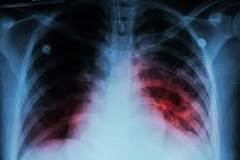A nurse is caring for a client who has tuberculosis. Which of the following precautions should the nurse plan to implement when working with the client?
Protective
Droplet
Airborne
Contact
The Correct Answer is C
Choice A reason:
Protective precautions are not necessary because they (also known as reverse isolation) are used for immunocompromised clients to protect them from potential pathogens carried by healthcare workers or visitors.
Choice B reason:
Droplet precautions are not necessary because they are used for infections spread through larger respiratory droplets, like influenza or pertussis.
Choice C reason:
Airborne precautions should be implemented by the nurse. Tuberculosis (TB) is primarily transmitted through the airborne route, as the bacteria that cause TB can be suspended in the air as tiny particles (droplet nuclei) when an infected person coughs, sneezes, speaks, or sings. These particles can be inhaled by others, leading to the potential transmission of the disease.
Choice D reason:
Contact precautions are not necessary because they are used for infections that are transmitted through direct contact with the client or contaminated surfaces, such as MRSA (Methicillin-resistant Staphylococcus aureus) or C. difficile.

Nursing Test Bank
Naxlex Comprehensive Predictor Exams
Related Questions
Correct Answer is B, C, E, D, A
Explanation
B. Provide adequate lighting to inspect the abdomen: Adequate lighting is important to ensure that the nurse can clearly see and assess the client's abdominal area. This step helps identify any visible abnormalities, such as skin changes, scars, masses, or distention.
C. Listen to the abdominal arteries using the bell of a stethoscope: Listening to the abdominal arteries helps the nurse assess blood flow and detect any abnormal vascular sounds, such as bruits or murmurs. This step provides information about vascular health and potential issues related to blood flow.
E. Locate liver and spleen borders by pressing hands 2.5 to 7.5 cm (1 to 3 in) into the abdomen: Palpating and locating the liver and spleen borders help assess the size and position of these organs. It can help identify hepatomegaly (enlarged liver) or splenomegaly (enlarged spleen), which could indicate various underlying conditions.
D.Check for areas of tenderness by pressing fingers 1.3 cm (0.5 in) into the abdomen: Palpating the abdomen for tenderness helps identify areas of discomfort or pain. It can provide information about potential inflammation, organ enlargement, or other sources of discomfort
Correct Answer is ["A","D","E"]
Explanation
A. Place the client in a room with positive air flow: Placing the client in a room with positive air flow helps prevent the spread of infectious agents within the healthcare facility. This is particularly important for clients with airborne infections.
D. Provide a mask for the client when they are outside their room: Providing a mask for the client when they are outside their room helps prevent the spread of infectious agents to others if the client has a contagious respiratory infection.
E. Don a gown when entering the client's room: Wearing a gown upon entering the client's room helps protect the nurse from contact with the client's body fluids and reduces the risk of transmitting pathogens to other clients or healthcare workers.
B. Perform hand hygiene with at least 4 to 5 mL of hand sanitizer when leaving the client's room: Hand sanitizer is not a substitute for proper handwashing with soap and water. Hand sanitizer may be used in addition to handwashing, but it is not used with such a specific quantity.
C. When removing personal protective equipment, remove gloves first: When removing personal protective equipment, the correct sequence is to remove gloves, perform hand hygiene, and then remove other items such as gown, mask, and eyewear. This helps prevent contamination of the hands during the process.
Whether you are a student looking to ace your exams or a practicing nurse seeking to enhance your expertise , our nursing education contents will empower you with the confidence and competence to make a difference in the lives of patients and become a respected leader in the healthcare field.
Visit Naxlex, invest in your future and unlock endless possibilities with our unparalleled nursing education contents today
Report Wrong Answer on the Current Question
Do you disagree with the answer? If yes, what is your expected answer? Explain.
Kindly be descriptive with the issue you are facing.
